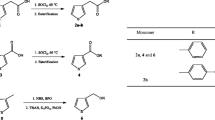Summary
The synthesis of polyphenylacetylene (1), polypentafluorophenylacetylene (2) and the block copolymer of 1 and 2 polyphenylacetylene-polypentafluorophenylacetylene (3) using a Rhodium catalysed living polymerisation reaction is presented. Photoelectron spectroscopy of thin films of the individual polymers using 50eV photons from a synchrotron allowed for the determination of the position of the the electronic energy levels, ionisation potentials and the vacuum level shift which indicated that the block copolymer organises at the gold substrate surface such that the fluorinated part of the copolymer extends towards the air interface. Pulse radiolysis time resolved microwave conductivity (PR-TRMC) allowed for the determination of the minimum carrier mobilities and the carrier lifetimes. The sum of carrier mobilities, Σμmin, were respectively 5.2·10–7, 6.3·10–7 and 3.2·10–7m2 V–1 s–1 and the first half life, τ1/2, was 2.0, 1.5 and 1.0 μs in 1, 2 and 3. The study shows that it is possible to make conducting block copolymers by the rhodium catalysed polymerisation of arylacetylenes with different electronic energies that organises at the surface giving rise to electronic properties that approach analogy to the traditional inorganic semiconductor pn-junctions.
Similar content being viewed by others
Explore related subjects
Discover the latest articles, news and stories from top researchers in related subjects.Author information
Authors and Affiliations
Rights and permissions
About this article
Cite this article
Krebs, F.C., Jørgensen, M. Conducting block copolymers. Towards a polymer pn- junction. Polymer Bulletin 50, 359– 366 (2003). https://doi.org/10.1007/s00289-003-0172
Received:
Revised:
Accepted:
Issue Date:
DOI: https://doi.org/10.1007/s00289-003-0172




